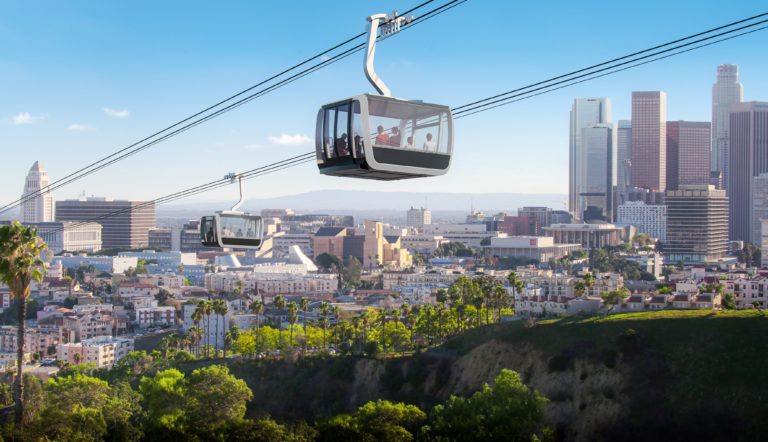
Aerial Rapid Transit Technologies, a company run by former Los Angeles Dodgers owner Frank McCourt, has proposed building a 1.4-mile elevated gondola tramway from Union Station, gliding over Chinatown and up to the Dodger Stadium parking lots in Elysian Park.
When McCourt sold the Dodgers to Guggenheim Baseball Management in 2012 for $2.3 billion, he retained ownership of the parking lots, which sit on about 130 acres on a hilltop overlooking downtown.
McCourt’s son Drew initially led Aerial Rapid Transit Technologies but has since moved on. Frank McCourt now leads the effort, according to a project spokeswoman.
The project calls for two elevated cable lines to run the length of the route, which runs north from Union Station and then turns west over Chinatown as it heads toward Dodger Stadium.
The route has a total elevation gain of roughly 250 feet, and the cable lines are to be held up by two towers.
A series of up to 30 gondola cars, traveling at speeds of up to 20 miles per hour, would make the trip, which would take between five and seven minutes each way. Each gondola could hold up to 40 people.
At times of maximum use, such as before and after Dodger games or other major events at the stadium, the system would be capable of ferrying up to 5,500 people per hour.
Similar gondola tram systems are operating in Portland, Ore.; on New York City’s Roosevelt Island; Mexico City; La Paz, Bolivia; and, Koblenz, Germany.
Another tram project has been proposed in the Los Angeles area by Warner Bros., starting from its Burbank studio lot and heading up to the Hollywood sign in Griffith Park. That proposal has been included in a study of access alternatives for Griffith Park being conducted by the city of Los Angeles.
In 2018, Aerial Rapid Transit Technologies convinced the Los Angeles County Metropolitan Transportation Authority to take up the Dodger Stadium gondola tram project.
The transit agency is now leading the environmental review process, which kicked off Oct. 1 with the filing of a formal Notice of Preparation and has a community input meeting scheduled for Oct. 22.
“This is an important step in making this project a reality,” Rebecca Liu Morales, spokeswoman for Aerial Rapid Transit Technologies, said in a statement.
“We know L.A. fans are eager to get back in the stadium to cheer on the Dodgers and hope that by moving forward with the environmental review process now, there will be an exciting new way to ‘rethink getting there,’” she added.
The notice of preparation contains a few more details on the project. The biggest revelation is the inclusion of two alternate paths for the portion of the route that goes over Los Angeles State Historic Park. Having two alternatives will help planners to lay out options for the best placement of a station to give riders the greatest access to the park, Morales said.
The notice of preparation also laid out a more detailed timeline for the project. The environmental review process is expected to take two years. Construction is not expected to start until 2025, with a completion goal of early 2028, just ahead of the Summer Olympic and Paralympic Games scheduled for later that year.
One item not spelled out in the notice document is the project’s cost. Aerial Rapid Transit Technologies pegged the budget at around $125 million when it initially presented the project to Metro in early 2018.
But last week, Morales said, “We expect the project will cost significantly more than the original estimate. As part of the environmental review processes, we will be studying specific station locations, routes and community benefits that will inform the final cost of construction.”
